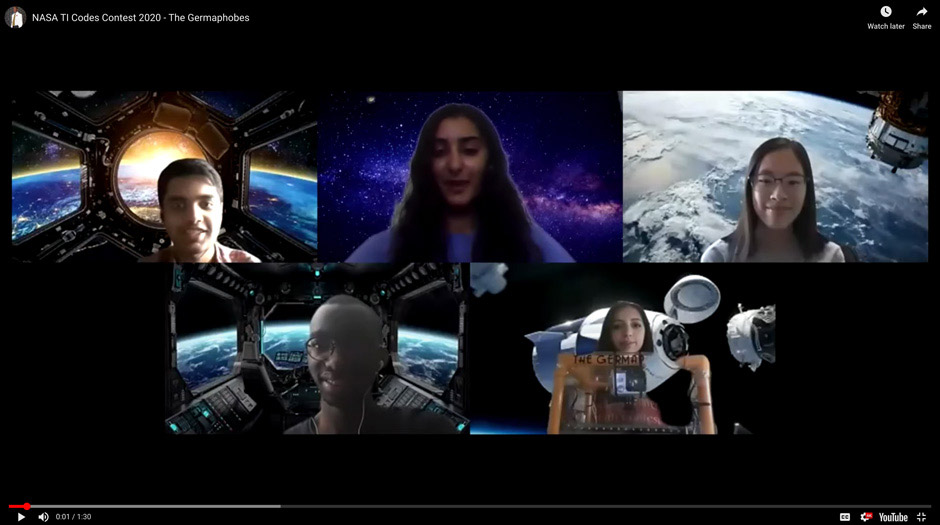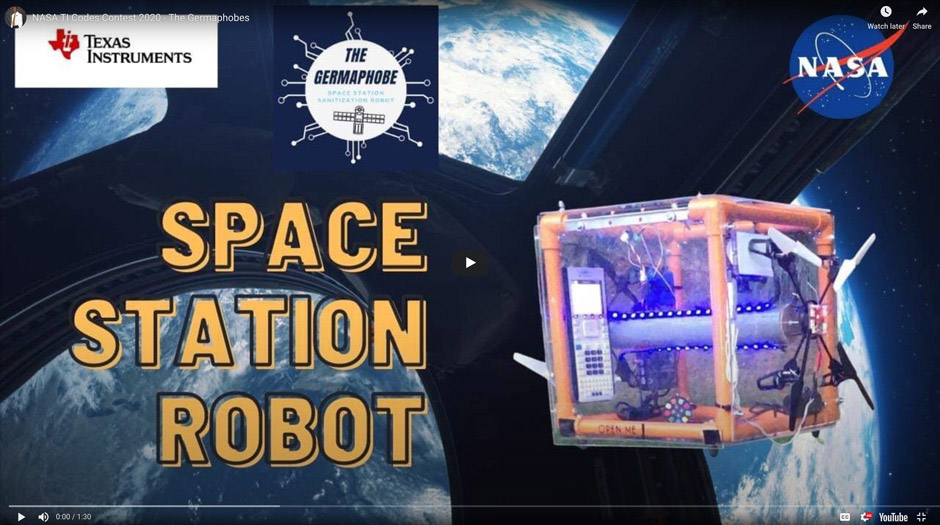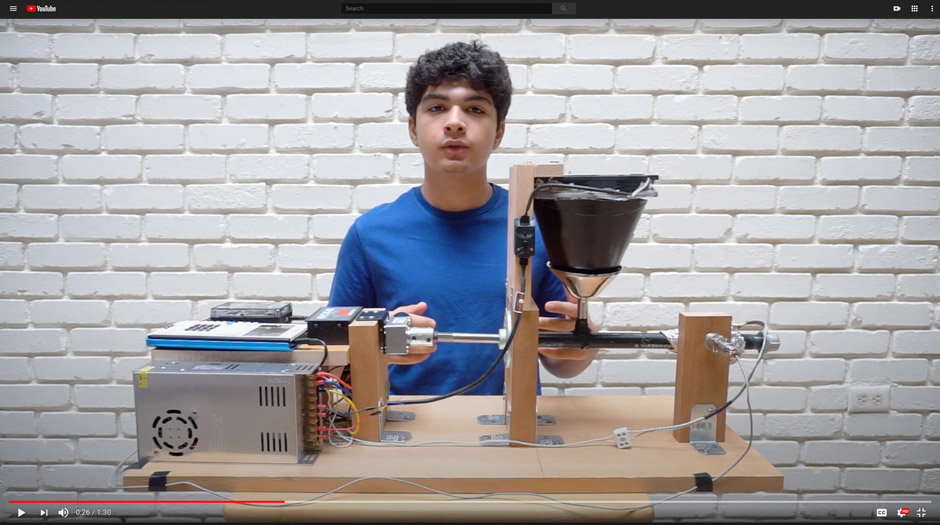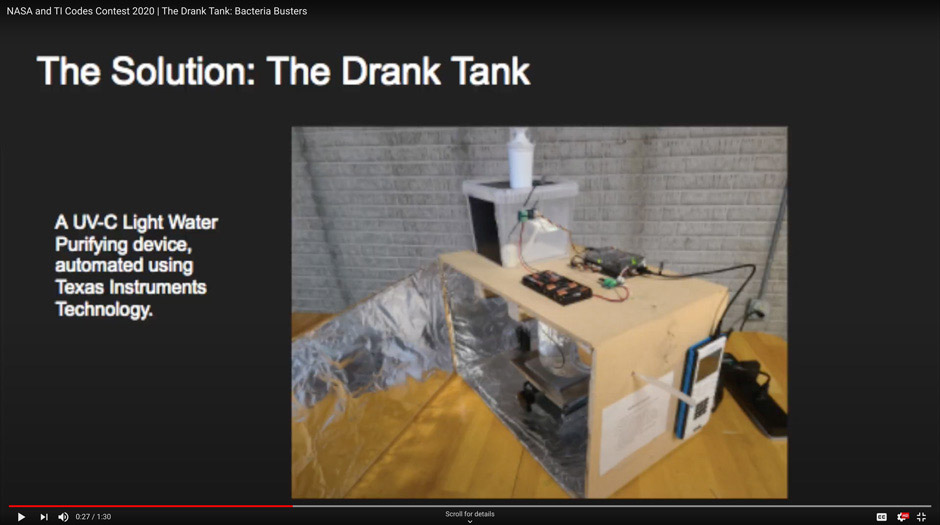TI Codes Contest Winners Revealed
Texas Instruments (TI) teamed up with NASA earlier this year to host the TI Codes Contest, where students could compete in teams to put their programming, problem-solving and creativity into practice in a space-themed challenge. We asked students to think of ways to improve a process or product on the International Space Station (ISS) using TI technology.
Each team was tasked with putting together a brief video synopsis to present their concept as well as their prototype. In addition, the pandemic added an extra layer of complexity as the teams would have to work with each other remotely. The stage was set for a true test of the abilities and perseverance of this new generation of future engineers, scientists and STEM initiates.
We received dozens of entries, ranging from ways to make the ISS cleaner and safer for the astronauts, to making processes more efficient, to improving the quality of life aboard the station. The innovation and ingenuity the teams demonstrated was outstanding. Our judges had the difficult task of picking the winners out of so many forward-thinking and inventive solutions.
We are excited to introduce you to the winners of the contest. Each member of the following teams will receive a TI graphing calculator and TI’s calculator-controlled robotic vehicle, the TI-Innovator™ Rover. Their adult sponsor also wins a $250 gift card to help cover the cost of future class activities. Lastly, each team wins a trip to NASA’s Johnson Space Center in Houston, once travel conditions improve.
And the winners are ...
Grand prize winner:
The Germaphobes, including:
- Alayna Nguyen
- Jonathan Ngoy
- Manvi Sinvhal
- Manu Gupta
- Gianna Renzo
- Suzanne Hanna, Adult advisor
The team: The Germaphobes are a first in the history of the TI Codes Contest. Never before have we had a group of students, who have never met in person, collaborate in different states to brainstorm an idea, design and build their prototype, and create a video explanation. They plan to donate their TI prizes to continue STEM learning in their respective high schools.

The concept: A free-floating robot designed to sanitize surfaces on the ISS using UV light. Watch their winning video.

1st runner-up:
The Quaranteens, including:- Arshaun Faraji
- Mason Neumann
- Carson Caranza
- Rana Banankhah
- Reza Banankhah
The team: The Quaranteens drew upon their own life experiences during the pandemic, which mirrored some of the challenges astronauts face aboard the ISS. With the space station crew confined and materials limited, the idea for the 3D extruder stemmed from the Quaranteens own real-world need to efficient with available resources and repurpose existing materials into something new.
The concept: A 3D printer extruder that helps astronauts make efficient use of limited resources by recycling old prints into new, usable filament. See their video.

2nd runner-up:
The Bacteria Busters, including:- Evan Leong
- Tony Chen
The team: The Bacteria Busters drew their inspiration from past TI Codes Contest winners. Their research led them to study how unsanitary drinking water conditions affect the health and well-being of populations on Earth, and discover that astronauts aboard the ISS must still guard against accidental bacterial water contamination.
The concept: The Drank Tank — a water purifier that can function in zero-gravity conditions to ensure the supply of uncontaminated drinking water aboard the space station See their video.

Once again, congratulations to the winners and to all those who submitted entries to the contest. We greatly appreciate the intelligence and creativity displayed here. We hope that everyone who participated will come back next year for the TI Codes Contest in 2021.
Check out last year’s winners.
About the author: Matt Carson is a writer for Texas Instruments and a former contributor to Hilti Group, Gemmy Industries and the Perot Museum of Nature and Science. A graduate of the University of North Texas, Carson is also a published fiction author, game designer and naval history enthusiast. When he’s not writing, Carson is an avid reader and gamer with a lifelong passion for science, pop culture, anthropology and sociology. He believes that advances in technology are the key to actualizing the future.
Tags:
Tagcloud
Archive
- 2025
- 2024
- 2023
- 2022
-
2021
- January (2)
- February (3)
- March (5)
-
April (7)
- Top Tips for Tackling the SAT® with the TI-84 Plus CE
- Monday Night Calculus With Steve Kokoska and Tom Dick
- Which TI Calculator for the SAT® and Why?
- Top Tips From a Math Teacher for Taking the Online AP® Exam
- Celebrate National Robotics Week With Supervised Teardowns
- How To Use the TI-84 Plus Family of Graphing Calculators To Succeed on the ACT®
- AP® Statistics: 6 Math Functions You Must Know for the TI-84 Plus
- May (1)
- June (3)
- July (2)
- August (5)
- September (2)
-
October (4)
- Transformation Graphing — the Families of Functions Modular Video Series to the Rescue!
- Top 3 Halloween-Themed Classroom Activities
- In Honor of National Chemistry Week, 5 “Organic” Ways to Incorporate TI Technology Into Chemistry Class
- 5 Spook-tacular Ways to Bring the Halloween “Spirits” Into Your Classroom
- November (4)
- December (1)
-
2020
- January (2)
- February (1)
- March (3)
- April (1)
- May (2)
- July (1)
- August (2)
- September (3)
-
October (7)
- Tips for Teachers in the time of COVID-19
- Top 10 Features of TI-84 Plus for Taking the ACT®
- TI Codes Contest Winners Revealed
- Best of Chemistry Activities for the Fall Semester
- Best of Biology Activities for the Fall Semester
- Best of Physics Activities for the Fall Semester
- Best of Middle Grades Science Activities
- November (1)
- December (2)
- 2019
-
2018
- January (1)
- February (5)
- March (4)
- April (5)
- May (4)
- June (4)
- July (4)
- August (4)
- September (5)
-
October (9)
- Art in Chemistry
- Which Texas Instruments (TI) Calculator for the ACT® and Why?
- Meet TI Teacher of the Month: Jessica Kohout
- Innovation in Biology
- Learning With Your Students
- A first-of-its-kind STEM strategy charts path to help educators
- #NCTMregionals Hartford 2018 Recap
- The Math Behind “Going Viral”
- Real-World Applications of Chemistry
-
November (8)
- Testing Tips: Using Calculators on Class Assessments
- Girls in STEM: A Personal Perspective
- 5 Teachers You Should Be Following on Instagram Right Now
- Meet TI Teacher of the Month: Katie England
- End-of-Marking Period Feedback Is a Two-Way Street
- #NCTMregionals Kansas City 2018 Recap
- Slope: It Shouldn’t Just Be a Formula
- Hit a high note exploring the math behind music
- December (5)
- 2017
- 2016
- 2015
